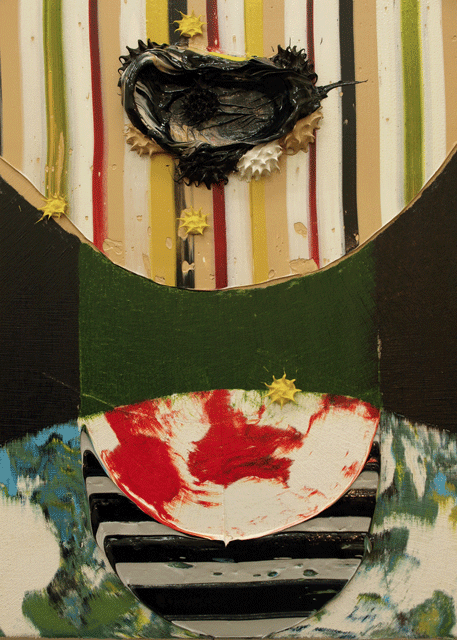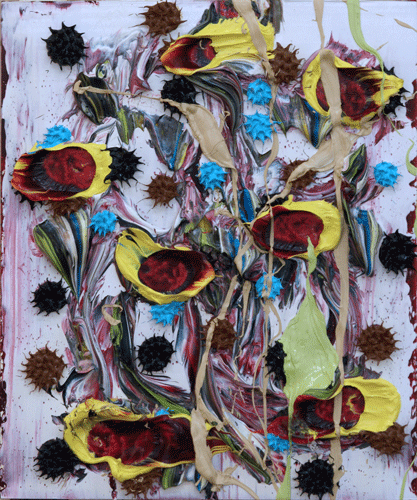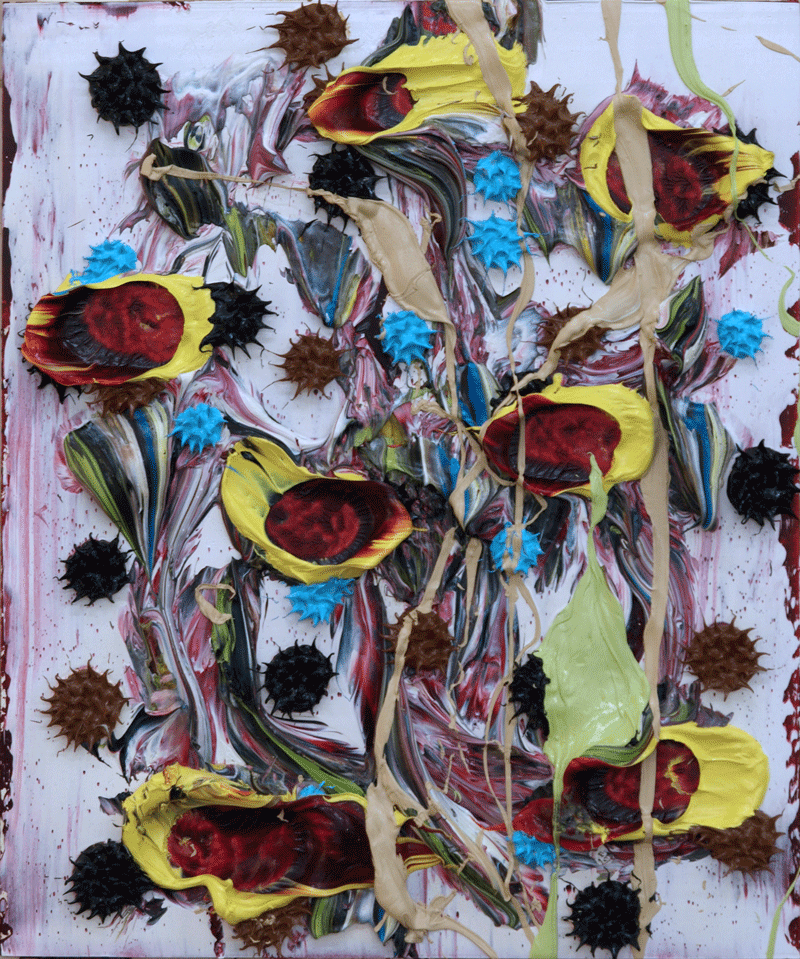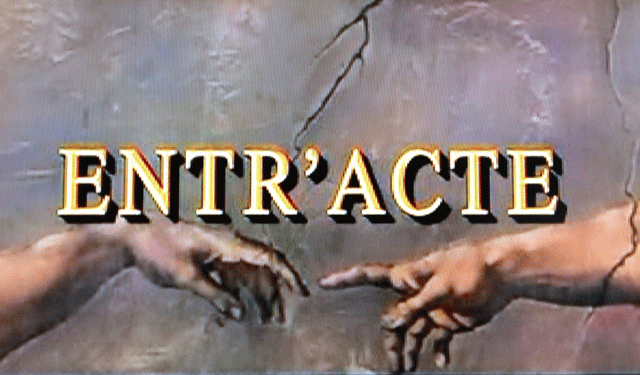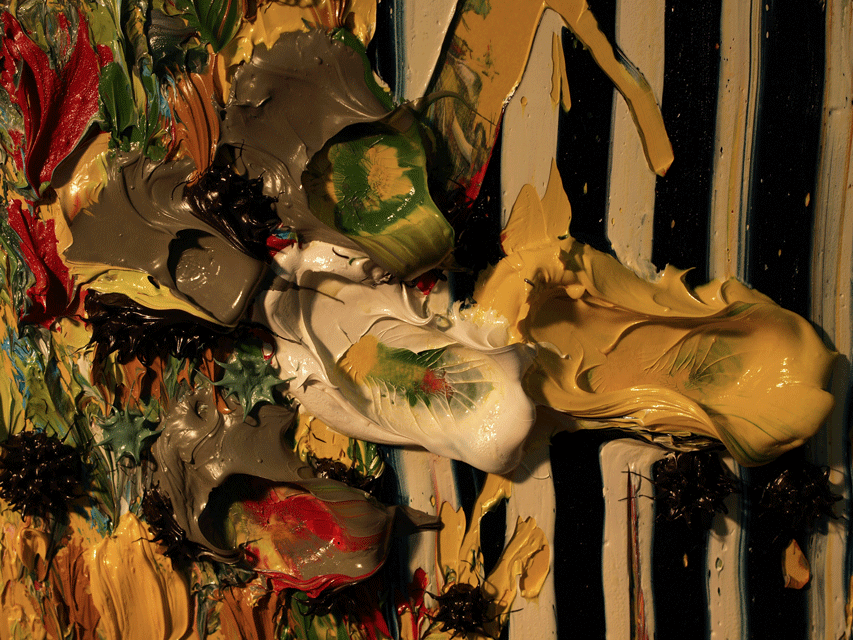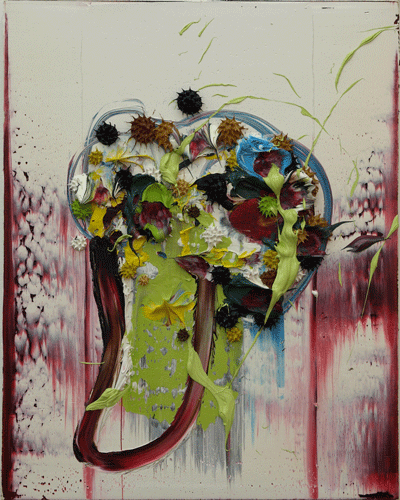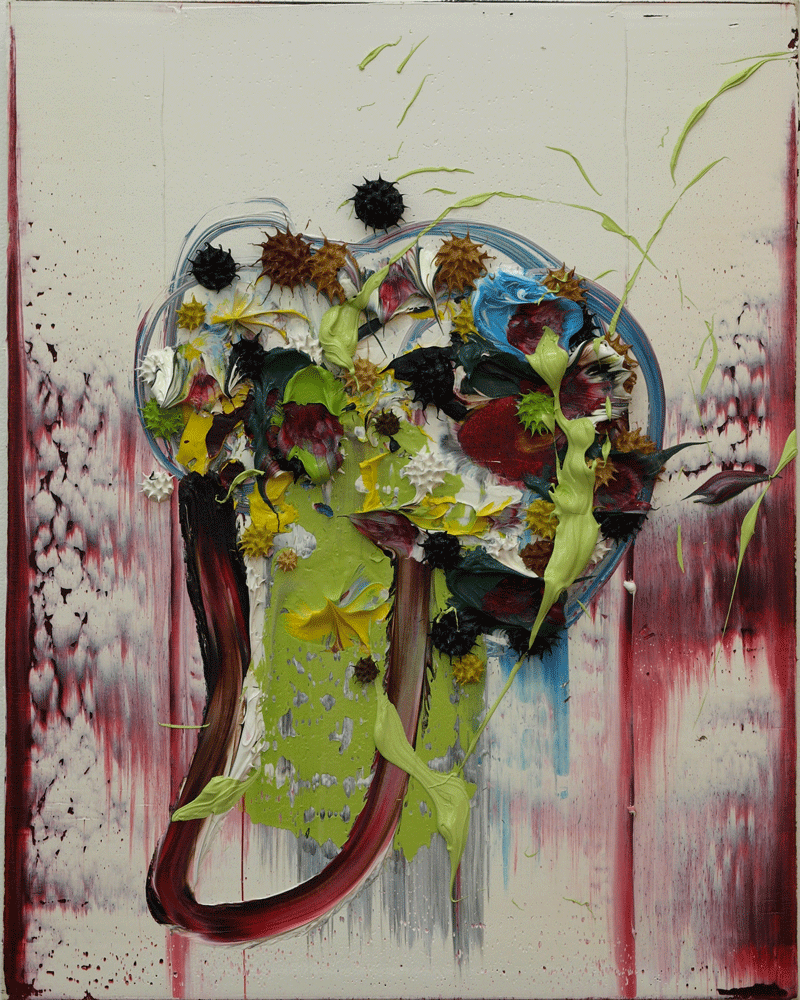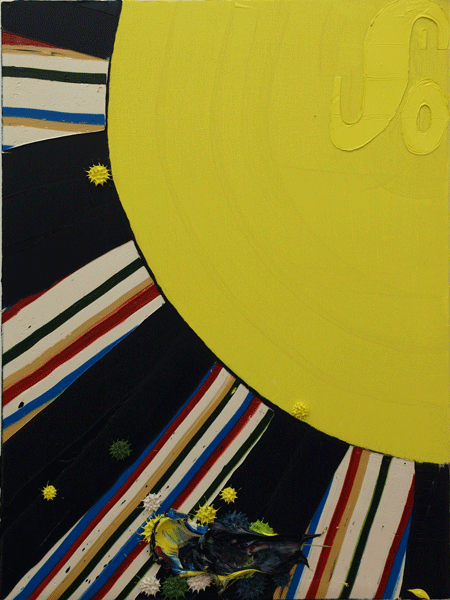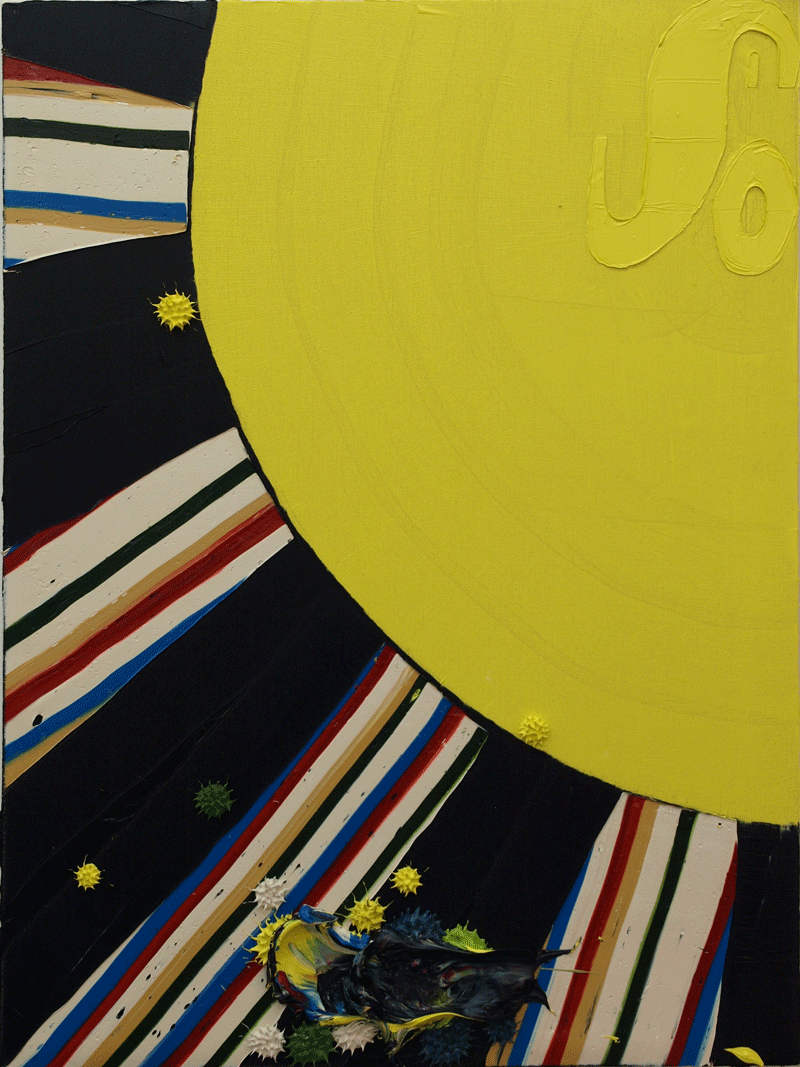December 29, 2011
Victory Over the Sun
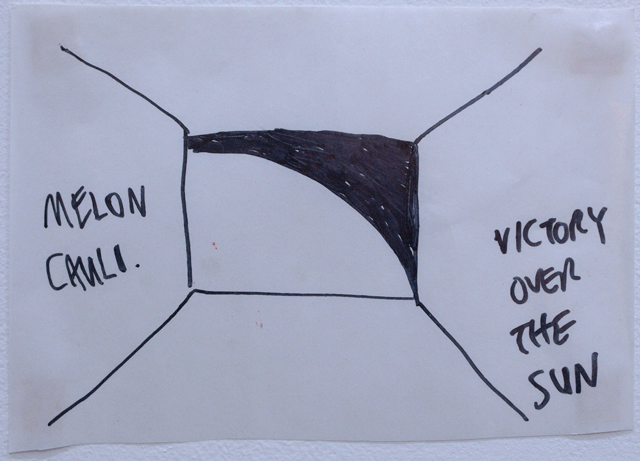
I was talking to Andrew Hahn the other night, describing my researches into Malevich. He jumped up and started to draw the image of Malevich's Victory Over the Sun from memory. As we have it, the actual image was at our fingertips on the web, and I immediately appreciated the differences: the outer square gone, the angle curved (so much like Orbital) and struck on the other side of the central square, which became a rectangle that conformed to the proportions of the scrap paper he was working on.
I was delighted: "Thanks for composing my next painting for me, this will do nicely!"
And melancholy? A grocery list: melon, cauli(flower).... which prompted me to mention the In Our Time podcast about Robert Burton's Anatomy of Melancholia, an excellent podcast, highly recommended:
Melvyn Bragg and his guests discuss Robert Burton's masterpiece The Anatomy of Melancholy.A nice cure for the blues: get up off your butt and shop for dinner.In 1621 the priest and scholar Robert Burton published a book quite unlike any other. The Anatomy of Melancholy brings together almost two thousand years of scholarship, from Ancient Greek philosophy to seventeenth-century medicine. Melancholy, a condition believed to be caused by an imbalance of the body's four humours, was characterised by despondency, depression and inactivity. Burton himself suffered from it, and resolved to compile an authoritative work of scholarship on the malady, drawing on all relevant sources.
December 28, 2011
Emphasis Mine
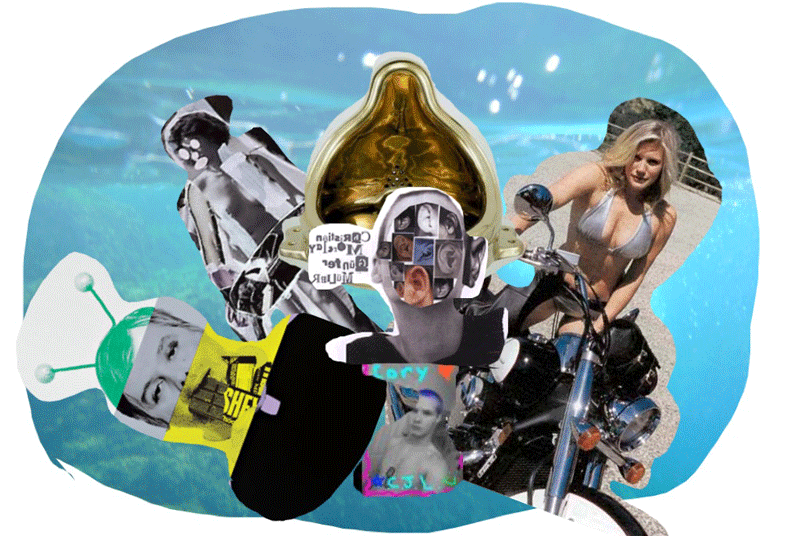
Everything in this post is lifted from an interesting NYTimes article about appropriation:
In a deposition in the case that was recently published as part of an unlikely art book by the writer and director Greg Allen, lawyers for Mr. Cariou follow Mr. Prince deep into the strange and often trackless territory of artistic intention. About as close as they get to pinning him down is that he wanted to use the borrowed pictures to explore his fascination with the painting of Willem de Kooning and also thought of his collages and paintings as part of an idea for a movie about a post-apocalyptic world in which Rastafarians, famous literary lesbians and others commandeer hotels on St. Bart?s.Well, that's one answer.
?So what are four lesbians from the early 20th century doing on St. Bart?s in, now, when there?s a nuclear war, like why are they there?? a lawyer asked Mr. Prince, who responded: ?Your guess is as good as mine. That?s what I do, I make things up.?At another point in the transcript of the deposition, a lawyer asked, ?What is the message??
Mr. Prince replied, ?The message is to make great art that makes people feel good.?
UPDATE: The Mixel image added above, the app mentioned in the article. This is now the second app that will I use to make collages from online and personal sources. The previous post, for example, was illustrated with WebCut.
The Kasimir Malevich Spectrum
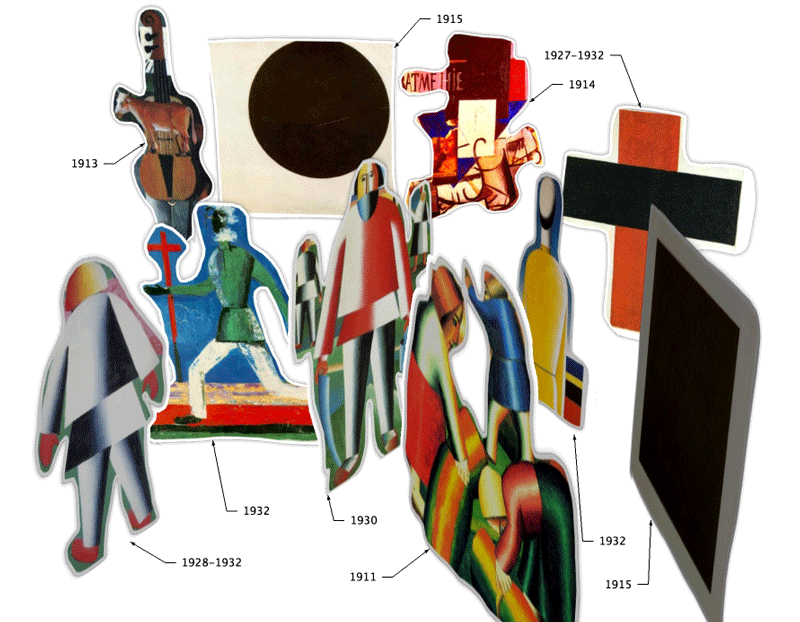
Why did Malevich devolve his Suprematism back to figuration? Or was this a re-evolution from a year zero forward? Was he reacting to Stalinist pressure to provide his own form of socialist realism? Was the avant gardist moment by internal necessity only a fugitive moment in history?
Searching on, I harvested the following fascinating links:
Here is a blockquote from artist John Goto, who based his work partly on the life of Malevich:
The final years of Malevich's life are poorly documented and the intentions behind the works he made remain uncertain. No historical consensus has emerged to explain why his paintings seemed to draw ever closer to the official Socialist Realist style, or to account for his practice of faking his own earlier works by dating images made during the early 1930s as if they came from the pre-Revolutionary period.In an attempt to unravel the mystery surrounding these late works, Goto makes a speculative reading of Malevich's life and images against the political and social event of the early Stalinist period. He picks up the story in 1927 when Malevich toured Poland and Germany with an exhibition that marked the high point of his career and was to guarantee his reputation in the West long after he was all but forgotten in the USSR. Even 'as glory falls like rain' upon Malevich, a sense of foreboding seems to have motivated a last will that he wrote in Berlin.
As the 1920s concluded Malevich, like many intellectuals, found himself under increasing pressure as articles and exhibitions were criticised or censored and his research post terminated. He was arrested in 1930 and questioned over several months. This period saw the first Five Year Plan introduced and also one of the first major trials of technicians scapegoated for the failures of industry. Stalin turned his attention to the countryside where the Party still lacked complete control and began a programme of forced collectivisation of the farms. The wealthier peasants, termed 'Kulaks', were deported in their millions. During the winter of 1932/3 a terrible famine swept the Ukraine.
The cancer that killed Malevich was probably diagnosed in 1933, but his requests to be allowed abroad for treatment were refused. After the assassination in 1934 of his rival, Sergei Kirov , Stalin unleashed the Great Terror which claimed the lives of countless millions including some of Malevich's old students and collaborators. Malevich died on 15 May, 1935.
Avant-garde and politics, Malevich, Stalin, Laibach by Tuomas Nevanlinna.
Kasimir Malevich - an introduction by Katrin Bettina M?llerThe fact that he returned to representational painting at the end of the twenties still creates confusion to this day. Did he give in, in the end? Or was he trying out new forms that he'd gained from Suprematism? What also makes the classification and evaluation difficult is the fact that Malevich in part gave incorrect dates to his works - namely from the time preceding Suprematism. One of his last paintings is a self-portrait in the style of Italian Renaissance painting. Yet instead of his name, he signed it with a black square in the bottom right-hand corner.
More of the big lie that ?Dream factory communism: the visual culture of the Stalin era?an exhibition at the Schirn Kunsthalle, Frankfurt By Marianne Arens and Sybille Fuchs:
As noted earlier, works of Kasimir Malevich are also exhibited, including three paintings: ?Three Girls? (1928-32), ?Three Women on a Road? (1930) and ?Female Harvesters? (1928-29). These works fall completely outside the exhibitor?s framework of socialist realism. No one would be a more unlikely court painter to a privileged bureaucracy than Malevich, the founder of ?Suprematism.? Malevich became known through his pure abstractions such as a square or a circle. He placed, for example, his ?Red Square? provocatively on the site of a religious icon. The name ?Suprematism? was derived from the Latin supremus, ?the highest,? signifying for him, the surmounting of every ?Lie in the world of will and representation? through abstractions. Malevich, who contributed actively in the building of new structures of art and culture in the young Soviet state, fell into disfavour under Stalin because of his ?formalism,? was arrested for a time, contracted cancer, and died in isolation in 1935.The exhibition?s notes hardly refer to the bitter conflict between the major artists and the Stalinist bureaucracy. Instead, in the case of Malevich, for example, it states: ?In the late 1920s many of the Russian avant-garde artists began a gradual transition to pictorial portrayal of people?above all the longed for ?new men.? This involved the transition from the early avant-garde abstractions to figuratives and the photographic character of ?socialist realism.??
However, when Malevich in his later works again turned to painting, his work in no way represented a transition to socialist realism. So the depiction in the exhibition of strapping ?Female Harvesters? with their flared skirts and blouses set in a sunny landscape appears rather as an ironically distant reference to a no-longer-existing idyll.
And more: Malevich $17 Million Sale Finally Buries Stalinism By Hilton Kramer:
Who, then, was Kazimir Malevich? This hero of Russian modernism was actually of Polish-Ukrainian origin, and it may truly be said of him that of all the pioneer creators of abstract art in the 20th century, none was more extreme in his artistic ambition, none more alienated from the world that produced him, and none, in the end, more thoroughly compromised by the circumstances that marked the demise of all his hard-won accomplishments.It is not a historical rarity in the modern age for artists to entertain megalomaniac illusions about the importance of their work and its power to transform the world in which they live, yet even by the standards of his age and milieu, Malevich stands out as a special case. For in the final analysis, this charismatic artist, mystic and revolutionary set himself up as a rival to no less an adversary than God, and with a demonic confidence in the occult power of the avant-garde movement, which he founded in 1915 and gave the name Suprematism, he entertained the delusion that he might finally triumph over death itself. Compared to Malevich, Mondrian was a pietist, and Kandinsky, an artist-intellectual of modest ambition.
The era in which Malevich came of age as an artist in Russia was one of the most extraordinary in the annals of the modern avant-garde-an era in which talent abounded, innovation was the watchword, and audacity the measure of all accomplishment. It was also, of course, a period of political tumult in which the rudiments of a bourgeois democratic system were attempting to take root in a society bounded by a failing autocracy and the dream of a total revolutionary upheaval. Here, too, theosophy and other schools of mystical thought flourished among artists, writers and intellectuals, and produced in the figure of Peter Demianovich Uspensky the mystical philosopher whose own variation on occult doctrine would be crucial to the development of Malevich?s-and Suprematism?s-art and theory.
All theosophical doctrine embraces as a fundamental tenet an unquestioning belief in immortality and reincarnation. It was Uspensky?s distinction that he carried this belief to a further extreme, propounding the notion that there was a ?fourth dimension? to existence that allowed the spiritually elect to overcome the bondage of death in the material world and enter the timeless universe of the spiritual life. This mystical doctrine was outlined in two books, The Fourth Dimension (1909) and Tertium Organum (1911), writings that enjoyed an enormous vogue in Russian artistic circles at the very moment Malevich was making his way, as an artist, through the succession of styles-from Impressionism to Art Nouveau to neo-Primitivism and Cubo-Futurism-that led him to the frontiers of abstraction.
It was another special feature of Uspensky?s philosophy that it specified that ?a cube, a sphere, a pyramid, a cone, a cylinder, may be projections or cross-sections of four-dimensional bodies unknown to us.? In Uspensky?s mystical cosmology, geometric form was thus believed to signify the victory of the spirit over death. It was with this metaphysical warrant that Malevich, in 1915, created the art of Suprematism, a mode of pure abstraction based on the use of the square, the cube and the cross-forms on which he conferred first a religious and then a political significance.
Exhibition in Bielefield, Germany?Kazimir Malevich: The Later Work By Sybille Fuchs:
During this difficult time in his life, Malevich started painting in a new style without, however, distancing himself from the artistic insights he had gained during his earlier period. In the few years left to him (he died of cancer in 1935) he clearly waged a struggle for recognition at the very highest level of artistic achievement by returning to objective painting, and in a certain sense even re-creating his early work prior the Suprematist period, while at the same time seeking new forms of expression.As in his youth, he began once again to paint in the style of late Impressionism, following the tracks of Bonnard and Matisse and back-dating his canvases to 1908 or 1909. Other paintings are closer to C?zanne or are reminiscent of Fernand Leger's plump geometrical shapes and Picasso's work. Malevich appears to have passed through all the earlier stages of his artistic development again at a furious pace?Impressionism, Fauvism, Cubism and finally non-objective painting. He actually painted some of his early work (for instance, Washerwoman) a second time. In fact, several of the pictures displayed in Bielefeld have only recently been established by means of precise scientific examination as belonging to his later work.
Parallel and subsequent to these paintings with their clear reference to the artistic movements of the early twentieth century and to his own early work, Malevich struck out in a new direction with paintings of usually faceless people positioned in a given space. These paintings are clearly reminiscent of Suprematism in their colours and shapes, but their abstractness has nothing more to do with the philosophical simplicity of the Black Square. It is not easy to interpret this return to objectiveness. It would certainly be wrong to see an adaptation to the demands of the bureaucracy or resignation in them. But nevertheless Malevich, as an artist, was reacting to the changes in society with the instruments of art. Perhaps one should see it as an attempt, by means of moving "one step back" aesthetically in leaving aside the formal severity of non-objectivity, to move one step forward in a new direction by placing the old into context to the new, to what could not as yet be realised.
UPDATE: Why am I interested in this subject? Much like Picasso, Malevich was aware of the popular notion of the art dialogue as if it were teleological, that it serves a purpose or end. But they both embraced earlier iterations or evolutions of form and content, returning freely to forms that they had pioneered along the way, in effect shuffling and equating and therefore negating the usual narrative of objective figuration evolving to non-objective abstraction (cue the Mondrian slide show). In other words, the territory of painting and art is bigger than either representation or abstraction. The answer is both representation and abstraction. In an epoch of space/time and particle/wave, could it be any other?
Timeline
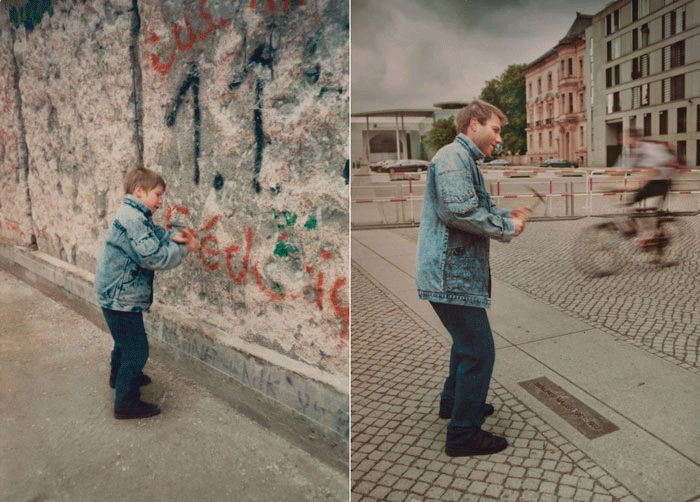
I love timelines. The work of Argentine photographer Irina Werning is fascinating: Back to the Future. Part one here. Click and browse and ponder entropy and the wonder of existence.
Apropos of this weekend, happy new year!
December 27, 2011
Work on Paper
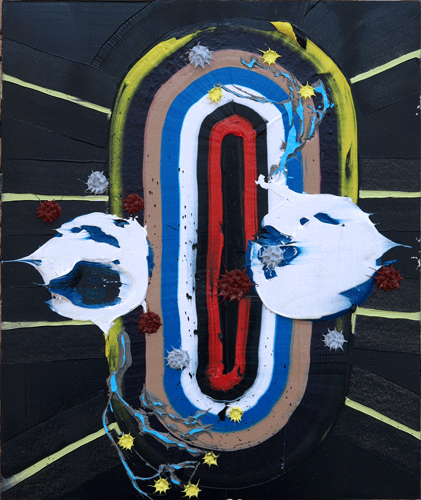
takin' it on the road.
WOP 21-11
2011
18"x15"
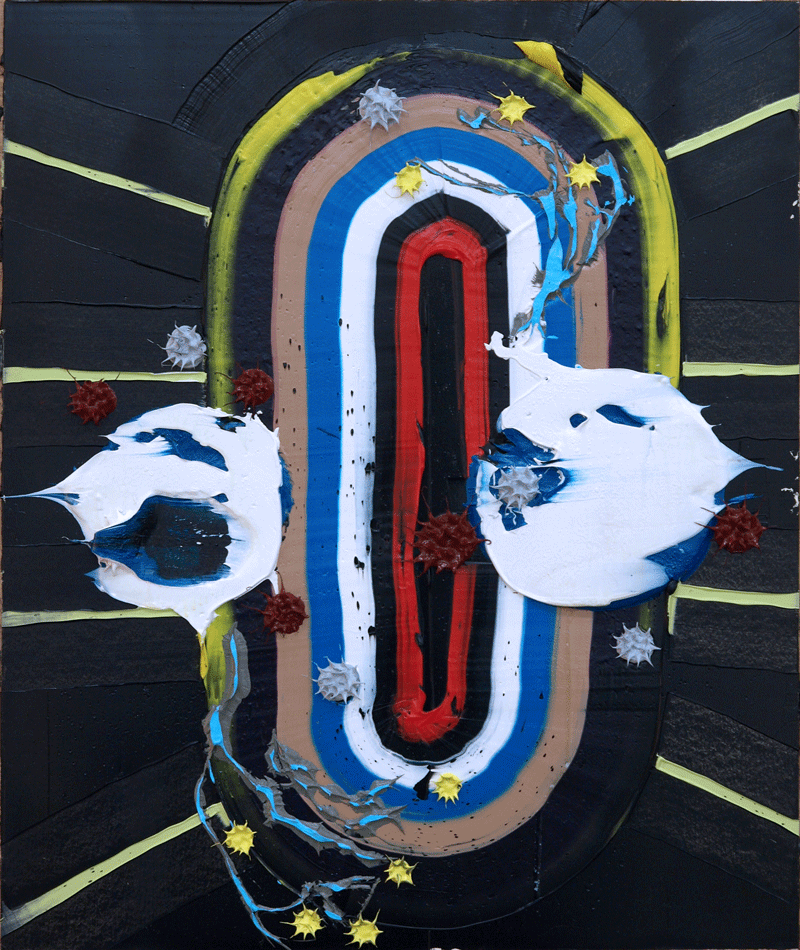
Superman or Homer Simpson?
Time= 16:00, Shakespeare: "What a piece a work is man! How noble in reason! How infinite in faculty! In form and moving how express and admirable! In action how like an angel! In apprehension how like a god!"
Time= 16:30, the title of this post.
This video is long by internet browsing standards, so why did I feel compelled to post it? Conceptuality is close to an absolute value in art today, it has been thus for about fifty year now, this is our entire postmodern epoch. Still to this day, I meet students fresh out of grad school who feel obliged to nod in this direction even though a majority of them are also aware of the need to question the assumption of the empire of the conceptual, usually via strategies of mixing in a commitment to materiality even as they position them as quotations and nods to art history (quotational art, this reminds me of early postmodern architectural theory, of early Charles Jencks and Venturi's Learning from Las Vegas!). Strong is the need to demonstrate intelligence via overt conceptual engineering. These acknowledgements seem to me to be intended to be designed with an architectural ambition, they are meant to be interlocking frameworks of historical references in lieu of striking out with a new formal discovery, the very thing that all art students have been taught for generations is impossible in our era. Formal innovation might have been impossible in the era of the information age, but this too is the mark of the late 20th century. Do we have to remind ourselves that we are living in the dawn of the 21st? I guess so.
So...
So I take to heart this suggestion from Dan Ariely, that pure rational conceptuality is simple and plain and not the best fit for an all too human world, human in the sense of human frailty, human in the sense of the importance of the value of poetics over the simplistically rational.
December 24, 2011
Bon Nadal, Tots!
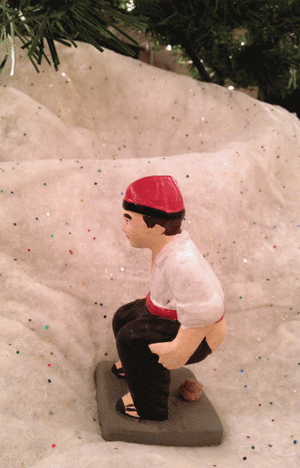
The title of this post is Catalan for: Merry Christmas, All!
The figurine above is a caganer. I've blogged about the caganer before. Here is a recent mention in the UK's Telegraph. Wikipedia eludicates:
Explanations(Pesebre means nativity scene in Catalan.)Possible reasons for placing a figure representing a person in the act of excreting waste in a scene which is widely considered holy include:
-Tradition.
-Perceived humour.
-A fun spectacle, especially for children.
-The Caganer, by creating feces, is fertilizing the Earth. According to the ethnographer, Joan Amades, it was a "customary figure in pessebres [i.e. nativity scenes] in the 19th century, because people believed that this deposit [symbolically] fertilized the ground of the pessebre, which became fertile and ensured the pessebre for the following year, and with it, the health of body and peace of mind required to make the pessebre, with the joy and happiness brought by Christmas near the hearth. Placing this figurine in the pessebre brought good luck and joy and not doing so brought adversity."
-The Caganer represents the equality of all people: regardless of status, race, or gender, everyone defecates.
Increased naturalism of an otherwise archetypal (thus idealised) story, so that it is more believable, more real and can be taken more seriously.-The idea that God will manifest himself when he is ready, without regard for whether we human beings are ready or not.
-The Caganer reinforces the belief that the infant Jesus is God in human form, with all that being human implies.
The character introduces a healthy amount of religious doubt to test one's faith.
Further opinions:-"The caganer was the most mischievous and out-of-place character of the pessebre's [otherwise] idyllic landscape; he was the "Other", with everything that entails, and as the "Other", was accepted, in a liberal vein, as long as he did not aim to occupy the foreground. The caganer represented the spoilsport that we all have inside of us, and that's why it is not surprising that it was the most beloved figure among the children and, above all, the adolescents, who were already beginning to feel a bit like outsiders to the family celebration." Agust? Pons
-"The caganer is a hidden figure and yet is always sought out like the lost link between transcendence and contingency. Without the caganer, there would be no nativity scene but rather a liturgy, and there would be no real country but just the false landscape of a model." Joan Barril
-"The caganer seems to provide a counterpoint to so much ornamental hullabaloo, so much emotive treacle, so much contrived beauty." Josep Murgades
-"The caganer is, like so many other things that have undergone the filtering of a great many generations, a cult object; with the playful, aesthetic and superficial devotion that we feel towards all the silly things that fascinate us deep down." Jordi Soler
December 23, 2011
December 21, 2011
DriveBy LA
Snow Globe Los Angeles from All Cut Up Films on Vimeo.
(Via Casey Chan at Gizmodo)December 19, 2011
December 16, 2011
December 13, 2011
Ho Chi Minh City
Traffic in Frenetic HCMC, Vietnam from Rob Whitworth on Vimeo.
(Hat Tip.)December 9, 2011
WPA: Bon Voyage
Bon Voyage WPA Holiday Exhibit from Andrew Pearson on Vimeo.
WPA's one year plan went to two and tomorrow they are having a grand closing/holiday celebration as they close down their space on ChinaTown's Bernard Street and subsequently contemplate their next move. It is a short exhibition that will only last two days, so be sure to catch it while it's up. The show is nearly installed and it already looks great with several stand out pieces such as Fil R?ting, Charles Irvin, Andrew Hahn, Ryan Tomcho, Pam Jorden and Bart Exposito. Here's the blurb on their website:Bon Voyage | Holiday Group Exhibition
December 10th-11th
Gallery Hours: 12?6pm, Sat-Sun.
Reception: Saturday, December 10, 6-10pmPlease join us for Bon Voyage, a special two-day exhibition and holiday party featuring work by all the members of WPA: Bart Exposito, Andrew Hahn, David Hughes, Charles Irvin, Pamela Jorden, Michael Minelli, Rachael Neubauer, John Pearson, Terri Phillips, Fil R?ting, Amy Sarkisian, Henry Taylor, Ryan Tomcho, Tyler Vlahovich.
WPA is takin' it on the road. Which "road" or which "it" we can't say right now; only that we will be moving from our Bernard Street space as of December 12, 2011. What started out as a one year proposal for a dozen or so artists turned into a two year commitment to a space that occupies not only the inherent traditions of the white cube but the challenges and possibilities offered through collective risk.
Holiday cheer and end of year celebrations await. DJ sets by the yams throughout the evening beneath the mistletoe and tinsel. Special hourly calendar raffle and discounts Saturday evening. We hope you can attend.
Marking this transition WPA has produced a 13-month calendar for the new year, a collaborative project featuring artwork by each of the members.
Gallery hours:
Limited edition of 100, including a unique rubberstamp collage by Dave Hughes, only available at the gallery - $20.
Open 12-6pm, Saturday-Sunday or by appointment.
December 8, 2011
LA DriveBy: Ice Cube Style
More Eames via one of LA's finest.
At time= 00:50, he makes a segway like a nasty record scratch.
(Hat Tip.)
December 6, 2011
The Known Universe
The Known Universe from AMNH on Vimeo.
This takes me back to the Powers of Ten by Charles and Ray Eames...
The advantage of the Eames version is the grounding in the familiar (a picnic), a scaling mechanism via meters, and a drill down into the picnic toward the smallest scale possible at that time, the proton.. The differences are interesting. "The edge of present understanding" has expanded quite a bit since 1977. The Powers of Ten only go to a 100 million light years, in the Known Universe, the cosmic horizon is the big bang. Note as well the huge blind sectors due to our galaxy's occluding spiral arms.
Handing Out Triple A's like Candy
Bethany McLean is unique in that she can break down all of the complexity of the current financial crisis in terms most people can understand, (The Interview Show's folksy presentation helps too, he doesn't pretend to have any expertise in the subject). She's talking about her book, All the Devils Are Here.
(I recommend an inspiring bio by Bethany McLean here.)
The C-Span interview is here.
"The ultimate form of corruption is not someone explicitly doing someone else a favor but the form of corruption that happens when everybody already thinks the same way."
Her co-author Joe Nocera's interview on Democracy Now! is here.
Essentially, she paints a tale of the proverbial road to hell initially being paved with good intentions, then the bad ones stealthily took over. All the devils are here, and everyone from top to bottom, everyone including ourselves, we who had heard of the availability of unrealistic mortgages in the years shortly preceding 2008 going down without freaking out in the street with a megaphone, we, all of us are not exempt from the list. Listening to this, I wonder how we can possibly control the devolution or corruption of a given rule set, especially the ones grinding gears in the mist of this epic story.
Time 18:06 What happened to the rating agencies?
"It's kind of a tragic story by the way because the rating agencies are the little grunts of wall street. They were the people were those responsible for looking at debt, debt of a company, debt of a country, and saying: what are the chances of this debt being paid in full and on time? And for a lot of years, they rated cop orate debt or the debt of a country, they didn't do this complex stuff called structured finance which was what mortgage backed securities are, but they slowing and surely started doing this in part with some prodding by the government?
Over time the culture of the rating agencies became corrupted where the analysis was no longer first and foremost and instead they wanted to keep these rich money flows coming in, rating this stuff triple A..."
Here is another good summary from another angle of what has happened and what is still unraveling by a writer that goes by the pen name Spengler, for Asia Times, The Monster and the Sausages:
There is nothing complicated about finance. It is based on old people lending to young people. Young people invest in homes and businesses; aging people save to acquire assets on which to retire. The new generation supports the old one, and retirement systems simply apportion rights to income between the generations. Never before in human history, though, has a new generation simply failed to appear.As the above chart makes clear, America's population profile is far more benign than Germany's, but it is aging nonetheless. There simply aren't enough young people in America to borrow money from Europe's and Japan's aging savers.
The world kept shipping capital to the United States over the past 10 years, however, because it had nowhere else to go. The financial markets, in turn, found ways to persuade Americans to borrow more and more money. If there weren't enough young Americans to borrow money on a sound basis, the banks arranged for a smaller number of Americans to borrow more money on an unsound basis. That is why subprime, interest-only, no-money-down and other mortgages waxed great in bank portfolios.
As l read and listened, the thought of mapping this story over our art world took hold. The idea of art as investment is commonplace in our art world. Is there any way that it can go wrong? Joe Nocera centers his blame on Alan Greenspan and McLean says that the fault lies in human nature. Our art world is a vast unregulated market, a veritable Wild West. After the bubble burst in the stock market many years ago, money went into the housing market, and after that burst, the smart money went into the art world. Before this migration, the art world was a broader delta of markets, and after that the delta dried up and consolidated into fewer select streams of surer bets. Currently, the art market is going strong but only for the few. The smartest art investment money didn't collect just anything, but within fewer narrowly defined networks who hold the promise to corner the market on art that would have a good return on investment. We too have our own speculative traders of art where demand exceeds the supply, there are linkages of mutual interests who naturally organize themselves in order to establish and exploit perceived value of art.
What if rating agencies correlates with art world critics? Over time the culture of the rating agencies became corrupted, where the analysis was no longer the first and foremost. The reality of the decline or demise of art criticism is widely held in the art world today. Are we blowing a bubble in our own art world and is this the kind of bubble that can pop? Or is the horizon of true value for art too far distant in the future to compel a burst in our time?
UPDATE: One last link on an article in the Daily Beastby Blake Gopnik and snip:
NEW MONEY SKEWS THE MARKETUPDATE 2: Check out this paragraph in an article by Jerry Saltz in ArtNet Adam LindemannAS money stacks up in the BRIC countries (Brazil, Russia, India, and China), their oligarchs are buying into the wealthy Western mainstream by forking out for its art, the way their poorer compatriots are buying into skinny jeans and Lady Gaga. Broad, a billionaire himself, says that for these new buyers ?it seems money is no object.? It has come to the point where such ?artigarchs? are pricing the normally rich out of the game. One veteran collector from the mid-Atlantic region says that he used to be able to buy a Gerhard Richter painting for ?six figures, or in the low sevens.? But now, with so much new money pouring into that market (the Russians are crazy for Richter), you?d be lucky to pay 10 times such amounts. ?I?m finding that the art that I love I can no longer afford, and the art I can afford I don?t know if I love.?
One colleague of his from New York explains that to get a new work by a popular artist such as Jeff Koons even most billionaires have to wait in line and jump through dealers? hoops. Anyone out of time or out of favor?or just new to the whole system?will have to head to the auctions and spend whatever it takes. Doubling down on a piece others also want is about ?a normal mammal need for success in a competitive environment,? the collector says, and dares any of his peers to deny it. ?Eli Broad wants to get it ahead of [Fran?ois] Pinault who wants to get it ahead of [Bernard] Arnault,? he says, rattling off the names of some of art?s megabuyers.
THE PRINCE OF THE ONE PERCENT:
It looks like the art world has entered an ugly finger-pointing period. Call it the Shoot the Wounded Phase: players at the top are starting to accuse each other of being craven, cronyistic bad actors. Everyone knows something bad is brewing, that some end or explosion is imminent amid the obscene prices, profligate spending, celebrity-artist worship, obnoxious behavior of the rich and art as entertainment. People are showing up to say, ?It wasn?t me. It was him! It was her! It was them!?
Now that's a lash of the bull whip dipped in gasoline lit on fire.
But doesn't this feel the same as it did when people were talking about those impossible loans (I pluck an example from memory) for $300,000 houses made over the phone with no credit, no money down back in 2006?
Saltz goes on:
A few days after Lindemann?s column came out, the megamogul supercollector Charles Saatchi stepped into the arena, publishing an article in the Guardian. ?Being an art buyer these days is comprehensively and indisputably vulgar . . . the sport of the Eurotrashy, Hedge-fundy Hamptonites; of trendy oligarchs and oiligarchs; and of art dealers with masturbatory levels of self-regard.? Saatchi goes all out in his attack of the ?stupendously rich,? saying they don?t actually ?enjoy looking at art? and instead ?enjoy having easily recognized, big-brand name pictures, bought ostentatiously in auction rooms at eye-catching prices, to decorate their several homes, floating and otherwise, in an instant demonstration of drop-dead coolth and wealth. Their pleasure is to be found in having their lovely friends measuring the weight of their baubles, and being awestruck.? A much better writer, collector and thinker than Lindemann, and far more honest, Saatchi gets a lot right about ?the success of the ?ber art dealers [being] based upon the mystical power that art now holds over the super-rich.? But he never turns his grand-inquisitor beam on himself, or explains how, somewhere along the line, he went off-track and lost his eye. He himself originated, and has long been the top player in, this terrible business. Good writing aside, it may be that this multimillionaire is a little upset that he?s being displaced by multibillionaires.
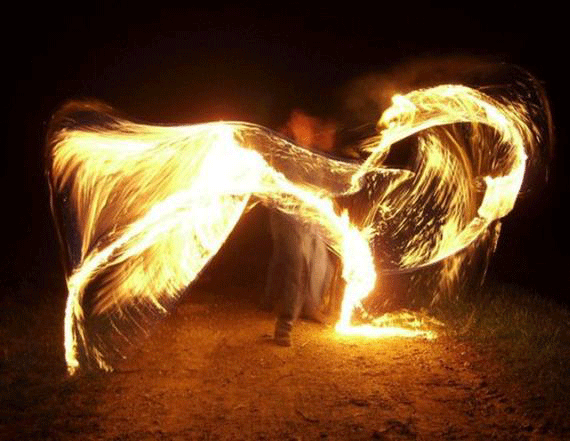
(Source.)
Painting
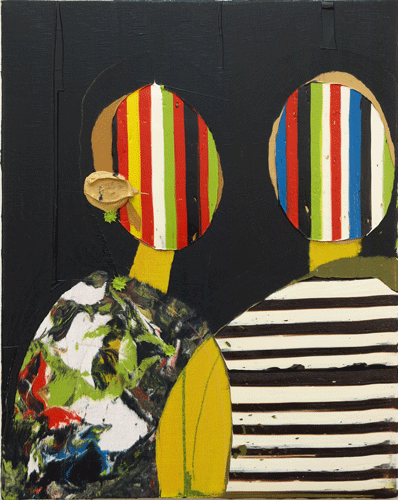
Anti-Delusionists
#393
2011
30"x24"
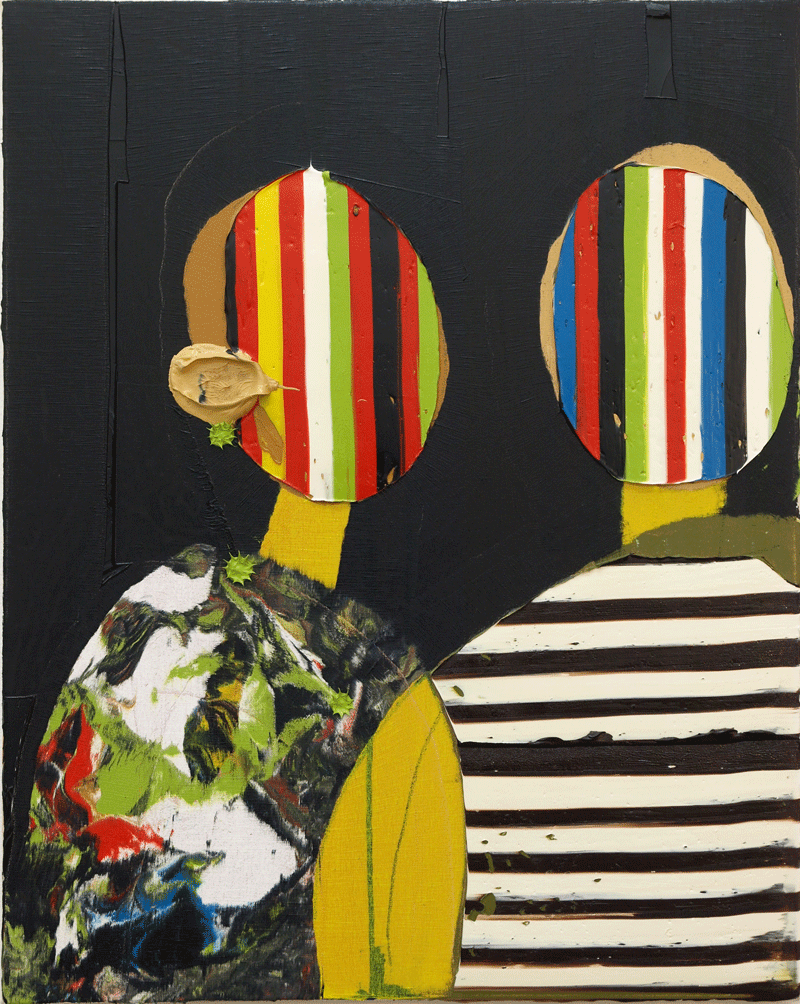
The story behind this painting: One Sunday, I returned to the studio after the day of an opening in Chinatown where a late night party was had in my studio involving several friends who had access to the space. I went home early that night and came into the studio to witness the normal litter after the party, beer bottles, cigarette butts littered the floor, normal stuff. I wanted to start painting from a stack of small canvases that I had prepared before the summer travels, I was relishing the thump of prepped canvas over stretchers, something I don't use so much since the majority of my practice is on canvas stretched over wood panel.
I cleaned up and sent into my storage bay to select a new canvas and turned to the wall was a painting made apparently the night before, the tell tale magic marker of Henry Taylor and inchoate dabbling by others with less or no painterly skill, no doubt degraded by drink and smoke. I was pissed but I also know the unwritten rule being that there are no rules and friends have carte blanc to make whatever strikes their fancy and is sparked by inspiration. But this piece of art wasn't art yet, despite our era's credo that anything so nominated was art, it was clear to me that this one hadn't achieved that status, at least no one had nominated it so with a signature or a ceremonious hanging for contemplation. Strangely, it was instead hidden with it's face turned to the wall in my back room.
After a little time performing forensic analysis and enduring a mild frustration that a perfectly good canvas was molested, I scraped off the drunken dabs, leaving the compositional gesture that bore Henry Taylor's trademark image of two people in marker. I decided to make lemonade from the lemon, take on Henry's composition and make the painting mine again. I thought that perhaps I could learn something, perhaps this could be a start of something new.
The title was drawn from a blogpost noting the opening of Rowan Wood's show at Anne Marten's home in Echo Park. It felt like a fit.
December 5, 2011
C.I.C.
This blogpost is about intuition and the psychology of mind. There's a lot of news lately about the mind and the distinction between what we know and do and what we think we know an do. It's been a few years since the introduction of Malcolm Gladwell's Blink.
...neuroscientist David Eagleman of Baylor College of Medicine argues that the unconscious workings of the brain are so crucial to everyday functioning that their influence often trumps conscious thought. To prove it, he explores little-known historical episodes, the latest psychological research, and enduring medical mysteries, revealing the bizarre and often inexplicable mechanisms underlying daily life.Favorite line in the video:
You're not seeing what's out there, you are seeing an internal model of what is out there.
This is Daniel Kahneman, talking about the marvels and flaws of intuition, culled from this article.
Interesting, right? I'm thinking about the years I spent aboard ship, watching radar scopes in the Combat Information Center, C.I.C. I'm thinking about philosophers such as Kant and Hegel and how they painted the distinction between the world and the model of the world as an inevitable intermediary and master illusionist. I'm thinking about theories of the intuition, there are several. I'm thinking about how much we really know about ourselves, about the mind as a multiple and singular entity. I'm thinking about morality and the consequences of multiple minds. I'm thinking about art, how the conceptualistic heart of postmodernity became distinct and defining. If the postmodern correlates with System Two, would modernism correlate with System One?
This brings to mind Frederich Shiller, who carved the distinction between the spontaneous, the naive, that which is equal to nature and the sentimental, that which is alienated from nature. The poet is either nature or he will seek her, the former is naive the latter is the sentimentalist.
December 2, 2011
Los vientos del monstruo en el sur de California

Para mis amigos que viven en Espa?a y Jap?n, aqu? algunas noticias de Los Angeles. Hemos tenido vientos incre?ble en el ?ltimo par de noches. No hab?a un sistema de presi?n alta clima de la costa de Alaska y otro sistema de baja presi?n en Arizona y la corriente en chorro curvado alrededor de los dos para crear un tobog?n de viento que cay? con una velocidad de hasta y tal vez m?s 120 millas por hora (120 es el l?mite de la capacidad de medici?n del equipo del cient?fico). Los ?rboles cayeron por toda la ciudad, muchos de ellos cayeron sobre las l?neas de energ?a y electricidad ha permanecido cortada durante miles de residentes todav?a en este momento. ?rbol del vecino de eucalipto cay? con estr?pito tremendo, fue creciendo a la orilla de nuestras propiedades y que cay? sobre la propiedad de su vecino del otro y en otro en el otro lado. Usted puede ver el contexto m?s amplio debajo de la tapa.
Las sirenas de emergencia se o?a todo el d?a en toda la ciudad, especialmente cerca de Pasadena y Glendale. T?cnicos de energ?a el?ctrica y los equipos de limpieza han estado trabajando horas extras desde que comenzara el evento. La fuerza del viento despojado ramas y las hojas de la vegetaci?n y las calles se amontonaban en los lugares con montones de hojas, ramas, hojas de palma y hojas. A medida que conduce a la autopista, las pilas de madera reci?n cortada reflejan el esfuerzo de respuesta a emergencias.
Un ?rbol cay? frente al estudio, as?, derribar la l?nea de alimentaci?n, privando a las viviendas cercanas y los equipos y trabajaron en el problema durante 24 horas hasta que se resolvi?. Fue otro d?a de fiesta de desastre para Los Angeles, un eco de terremotos, incendios, inundaciones y la ca?da ocasional de la estrella de Hollywood.
南カリフォルニアでのモンスターの風
スペインと日本に住んでいる私の友人のために、ここロサンゼルスからいくつかのニュースです。私たちは、夜の最後のカップル上素晴らしい風があった。そこにアラスカ沖の高圧気象システムとアリゾナ州を経由して別の低気圧だったとジェットストリームが最大と恐らく1時間あたり120マイル以上(120があるの速度で落ちて風のトボガンを作成するには、両方の周りに渦巻いた)科学者の機器の測定能力の限界。木は、市内各地落ちたそれらの多くは、電力線を介して落下し、まだこの時点で住民数千人のためにパワー出てきました。私たちの隣人のユーカリの木は、それが私達の特性の端に成長して、驚異的なクラッシュで落ち、それが反対側に私達の他の隣人の財産を越えて別のに落ちた。
緊急サイレンが街、特に近隣のパサディナとグレンデールにわたって一日中聞くことができる。イベントが始まって以来、電気電力技術とクリーンアップの乗組員は残業を進めている。風の力は、植物から死んだ手足や葉を除去し、通りには葉、枝、ヤシの葉と殻の山がある場所に山盛りされた。あなたが高速道路をドライブとして、直前にカット木材のスタックは、緊急対応の努力を反映している。
ツリーは、それが解決されるまで近隣の家とし、24時間問題に取り組んだ乗組員を奪って、電源ラインを切断するだけでなく、スタジオの前に落ちた。それは、ロサンゼルスのための別の災害の休日、地震のエコー、火災、洪水、時折倒れたハリウッドスターだった。
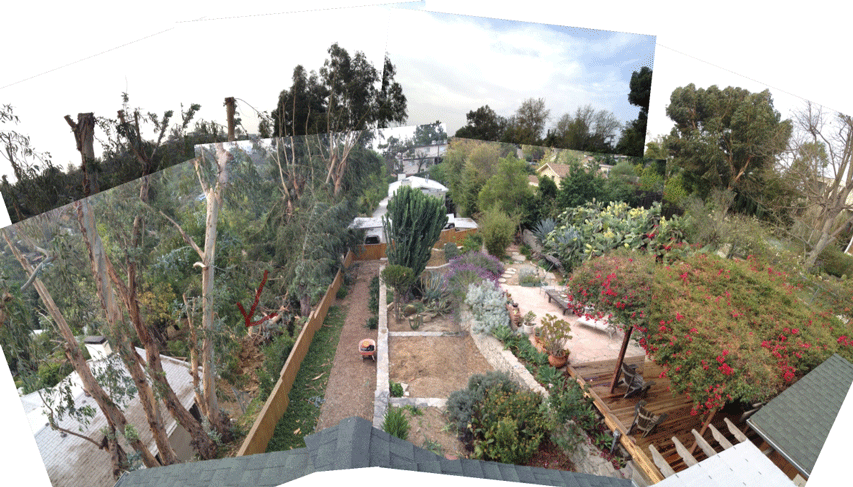
(Note: I led this post with translations in order to connect better with my Spanish and Japanese audience, via the power of Google Translate. This is a modest experiment and an effort to paint a picture of life here in my context, something I think that I do badly while I am in Los Angeles, save the LA DriveBy posts. There is a life that could be more vividly painted between my studio interior and the overall city, but such a forest of confidences that so difficult to parse, that it is best to err in discretion.)
For my friends who live in Spain and Japan, here is some news from Los Angeles. We have had terrific winds over the last couple of nights. There was a high pressure weather system off the coast of Alaska and another low pressure system over Arizona and the jet stream curled around both to create a toboggan of wind that fell with speeds of up to and perhaps over 120 miles per hour (120 is the limit of the measuring capacity of the scientist's equipment). Trees fell all over the city, many of them fell over power lines and power has been out for thousands of residents still at this time. Our neighbor's eucalyptus tree fell with a tremendous crash, it was growing at the edge of our properties and it fell across our other neighbor's property and into another one on the other side.
Emergency sirens could be heard all day across the city, especially nearby Pasadena and Glendale. Electrical power technicians and clean up crews have been working overtime since the event began. The force of the wind stripped dead limbs and leaves from the vegetation and the streets were heaped in places with piles of leaves, branches, palm leaves and husks. As you drive the freeway, stacks of recently cut wood reflect the emergency response effort.
A tree fell in front of the studio as well, tearing down the power line, depriving nearby homes and and crews worked on the problem for 24 hours until it was resolved. It was another disaster holiday for Los Angeles, an echo of earthquake, fire, flooding and the occasional fallen Hollywood star.
